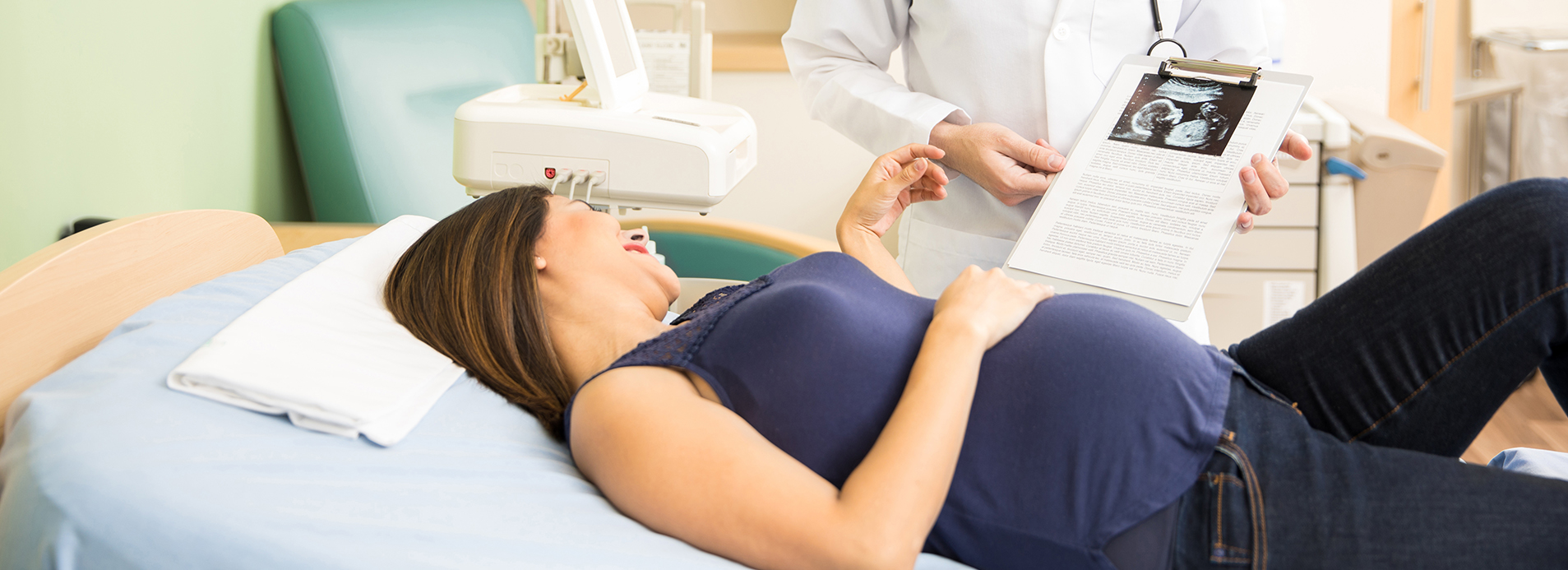Obstetrics
Preconceptual Counseling
Health education and promotion, risk assessment and intervention before pregnancy to reduce chances of poor perinatal outcomes.
D&C Dilation and Curettag
Procedure to remove tissue from inside your uterus; performed to diagnose and treat certain uterine conditions or clear the uterine lining after miscarriage or abortion.
In-Vitro Fertilization
Complex series of procedures used to help with fertility or prevent genetic problems, assisting with conception of a child. Mature eggs are collected from ovaries and fertilized by sperm in a lab.
Vaginal Delivery
Natural method of birth through the vagina “birth canal”. Hospital stay is typically 36-48 hours following delivery.
Cesarean Delivery
Surgical procedure performed to deliver a baby through incisions in the abdomen and uterus. Possibly planned ahead of time if pregnancy complications exist or because of previous C-section or patient is not considering a VBAC.
Ectopic Pregnancy
Occurs when fertilized egg implants and grows outside the main cavity of the uterus, most often in the fallopian tube, which carries eggs from the ovaries to the uterus.
Complications of Pregnancy or Childbirth
Complications during childbirth are termed obstetric labor complications, while those issues occurring after childbirth are puerperal disorders. Some complications might include gestational diabetes, high blood pressure, anemia, hypothyroidism, and other maternal risks. There may also be fetal and placental concerns with placenta abruption, accrete, ectopic pregnancy, miscarriage or other factors that make for high-risk pregnancies.
Uterine Leiomyoma
Benign tumors that arise from overgrowth of smooth muscle and connective tissue in the uterus. There may be a genetic predisposition to leiomyoma growth. Treated with myomectomy, an operation to remove fibroids while preserving the uterus.
Amniocentesis
Sampling of amniotic fluid that helps determine sex and detect abnormalities of fetus.
High-risk Pregnancy
Greater risk to the mother or fetus, placing additional physical and emotional stress on a woman’s body. High-risk pregnancy can be associated with high blood pressure, obesity, diabetes, epilepsy, thyroid disease, heart or blood disorders, etc.
4-D Ultrasounds
Non-diagnostic imaging that uses sound waves to create a live video style image of your baby in the womb.
Gynecology & Gynecologic Surgery
Diagnosis and Treatment of Reproductive system: Vagina, Uterus, Ovaries, Fallopian Tubes
- Clinical Breast Exams – physical exam done by health care provider during your regular medical check-up.
- Breast Disorders – includes common breast conditions like mastalglia (painful breasts), lumps, fibroadenomas (fibrous lump), breast cysts, benign fibrocystic disease, nipple discharge, mastitis (inflammation), and nipple/breast itchiness.
- Abnormal Pap Smears – the test found some cells on the cervix that do not look normal; should be performed during regular woman’s routine physical exam to help prevent cervical cancer.
- Incontinence – lack of voluntary control over urination or defacation
- Pelvic Pain – pain in the lowest part of your abdomen and pelvis with symptoms arising from the reproductive, urinary or digestive systems, or from musculoskeletal
- Sexually Transmitted Diseases – infections passed from one person to another through sexual contact. The causes are related to bacteria, parasites and viruses and number more than 20 types.
- Endometriosis – condition resulting from the appearance of endometrial tissue outside the uterus and causing pelvic pain.
- Pelvic Organ Prolapse – prolapse happens when the pelvis muscles and tissues can no longer support these organs due to weakness or damage.
- Urinary Tract Infections – an infection in any part of your urinary system: kidneys, bladder, ureters and urethra. Women are at greater risk than men.
- Abnormal Uterine Bleeding – abnormal bleeding between monthly periods, prolonged or heavy bleeding sometimes caused by hormone changes, cancer, fibroids, polyps or early pregnancy.
- Vaginitis – inflammation of the vagina sometimes caused by bad bacteria and other germs spread through sex.
- Herpes Genitalis – infection caused by herpes simplex virus type 2 (HSV-2) that is usually transmitted by sexual contact. Symptoms include recurrent attacks of painful eruptions on the skin and mucous membranes of the genital area.
- Hemorrhoids – swollen vein or group of veins in the anus region, typically caused by increased pressure in the lower rectum due to straining or chronic diarrhea or constipation.
- Ovarian Masses – growths on or in the ovaries of a woman that may represent either benign or malignant conditions.
- Polycystic Ovarian Syndrome – hormonal disorder common among women of reproductive age who may have infrequent or prolonged menstrual periods or excess mail hormone levels.
Surgeries include
- Hysteroscopic Surgery: Hysterectomy (removal of uterus), Myomectomy (removal of fibroids)
- Advances Laparoscopic Surgery
- Robotic Surgery
- Vaginal Surgery
- Endometrial Ablation
- Surgical Management of Ectopic Pregnancy, Endometriosis, Uterine fibroids, Congenital Anomalies, Vulvar Disorders
- Tubal Ligation for Female Sterilization
- Pelvic Organ Prolapse Management and Surgery
Cancer Screening
Gynecologic Malignancy
Cancer that starts in a woman’s reproductive organs including ovarian, cervical, uterine, vaginal and vulvar.
Breast Cancer
Mammography screening to identify abnormal cells line in the breast duct, which may become invasive cancer in some women.
Genetic Cancer Testing
Helps estimate your chance of developing cancer by searching specific changes in your genes, chromosomes, or proteins.
Infertility
- Diagnosis of inadequate levels of certain hormones in both men and women
- Treatment of includes hormone treatments, fertility drugs, and possible surgeries.
Menopause Hormone Therapy
Treatment usually includes medications containing female hormones to replace the ones the body no longer makes after menopause. Treatments have also been proved to prevent bone loss and reduce fracture in postmenopausal women. There are pros and cons associated with the therapy. Speak to one of our physicians regarding the type of therapy and products recommended to assure that it is customized to your needs and evaluated so that benefits outweigh the risks.


